15.3 The Environment
Learning Objectives
- List two reasons that make the environment an appropriate topic for sociologists to study.
- Describe two of the environmental problems facing the world today.
- Describe what is meant by the assertion that environmental problems are human problems.
- Explain the concepts of environmental inequality and environmental racism.
- Understand the various environmental problems that exist today.
At first glance, the environment does not seem to be a sociological topic. The natural and physical environment is something that geologists, meteorologists, oceanographers, and other scientists should be studying, not sociologists. Yet we have just discussed how the environment is affected by population growth, and that certainly sounds like a sociological discussion. In fact, the environment is very much a sociological topic for several reasons.
First, our worst environmental problems are the result of human activity, and this activity, like many human behaviors, is a proper topic for sociological study. This textbook has discussed many behaviors: racist behavior, sexist behavior, criminal behavior, sexual behavior, and others. Just as these behaviors are worthy of sociological study, so are the behaviors that harm (or try to improve) the environment.
Second, environmental problems have a significant impact on people, as do the many other social problems that sociologists study. We see the clearest evidence of this impact when a major hurricane, an earthquake, or another natural disaster strikes. In January 2010, for example, a devastating earthquake struck Haiti and killed more than 250,000 people, or about 2.5 percent of that nation’s population. The effects of these natural disasters on the economy and society of Haiti will certainly also be felt for many years to come.
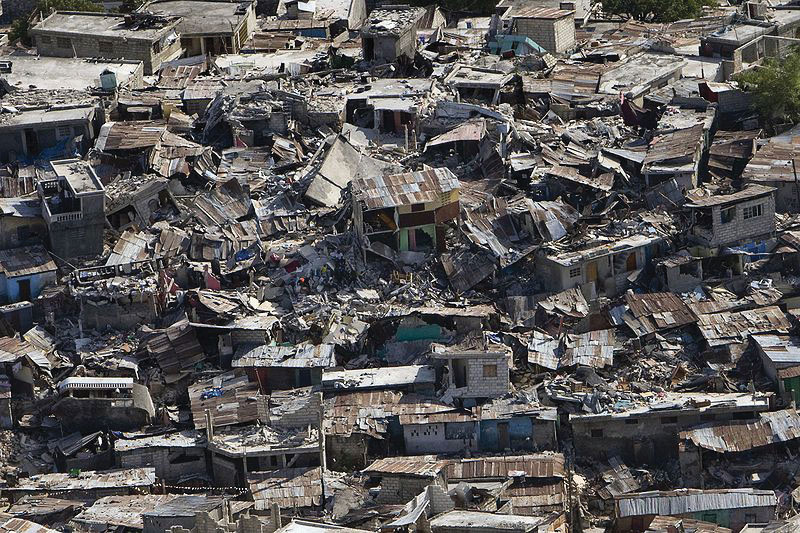
As is evident in this photo taken in the aftermath of the 2010 earthquake that devastated Haiti, changes in the natural environment can lead to profound changes in a society. Environmental changes are one of the many sources of social change.
United Nations Development Programme – Haiti Earthquake – CC BY-NC-ND 2.0.
Slower changes in the environment can also have a large social impact. As noted earlier, industrialization and population growth have increased the pollution of our air, water, and ground. Climate change, a larger environmental problem, has also been relatively slow in arriving but threatens the whole planet in ways that climate change researchers have documented and will no doubt be examining for the rest of our lifetimes and beyond. We return to these two environmental problems shortly.
A third reason the environment is a sociological topic is a bit more complex: Solutions to our environmental problems require changes in economic and environmental policies, and the potential implementation and impact of these changes depends heavily on social and political factors. In the United States, for example, the two major political parties, corporate lobbyists, and environmental organizations regularly battle over attempts to strengthen environmental regulations.
A fourth reason is that many environmental problems reflect and illustrate social inequality based on social class and on race and ethnicity: As with many problems in our society, the poor and people of color often fare worse when it comes to the environment. We return to this theme later in our discussion of environmental racism.
Fifth, efforts to improve the environment, often called the environmental movement, constitute a social movement and, as such, are again worthy of sociological study. Sociologists and other social scientists have conducted many studies of why people join the environmental movement and of the impact of this movement.
Environmental Sociology
All these reasons suggest that the environment is quite fittingly a sociological topic, and one on which sociologists should have important insights. In fact, so many sociologists study the environment that their collective study makes up a subfield in sociology called environmental sociology, which refers simply to the sociological study of the environment. More specifically, environmental sociology is the study of the interaction between human behavior and the natural and physical environment. According to a report by the American Sociological Association, environmental sociology “has provided important insights” (Nagel, Dietz, & Broadbent, 2010, p. 13) into such areas as public opinion about the environment, the influence of values on people’s environmental behavior, and inequality in the impact of environmental problems on communities and individuals.
Environmental sociology assumes “that humans are part of the environment and that the environment and society can only be fully understood in relation to each other” (McCarthy & King, 2009, p. 1). Because humans are responsible for the world’s environmental problems, humans have both the ability and the responsibility to address these problems. As sociologists Leslie King and Deborah McCarthy (2009, p. ix) assert, “We both strongly believe that humans have come to a turning point in terms of our destruction of ecological resources and endangerment of human health. A daily look at the major newspapers points, without fail, to worsening environmental problems…Humans created these problems and we have the power to resolve them. Naturally, the longer we wait, the more devastating the problems will become; and the more we ignore the sociological dimensions of environmental decline the more our proposed solutions will fail.”
Environmental sociologists emphasize two important dimensions of the relationship between society and the environment: (a) the impact of human activity and decision making and (b) the existence and consequences of environmental inequality and environmental racism. We now turn to these two dimensions.
Human Activity and Decision Making
Perhaps more than anything else, environmental sociologists emphasize that environmental problems are the result of human decisions and activities that harm the environment. Masses of individuals acting independently of each other make decisions and engage in activities that harm the environment, as when we leave lights on, keep our homes too warm in the winter or too cool in the summer, and drive motor vehicles that get low gas mileage. Corporations, government agencies, and other organizations also make decisions and engage in practices that greatly harm the environment. Sometimes individuals and organizations know full well that their activities are harming the environment, and sometimes they just act carelessly without much thought about the possible environmental harm of their actions. Still, the environment is harmed whether or not individuals, corporations, and governments intend to harm it.
A major example of the environmental harm caused by human activity was the British Petroleum (BP) oil spill that began in April 2010 when an oil rig leased by BP exploded in the Gulf of Mexico and eventually released almost 5 million barrels of oil (about 200 million gallons) into the ocean. Congressional investigators later concluded that BP had made a series of decisions that “increased the danger of a catastrophic well,” including a decision to save money by using an inferior casing for the well that made an explosion more likely. A news report paraphrased the investigators as concluding that “some of the decisions appeared to violate industry guidelines and were made despite warnings from BP’s own employees and outside contractors” (Fountain, 2010, p. A1).
Sociologists McCarthy and King (2009) cite several other environmental accidents that stemmed from reckless decision making and natural disasters in which human decisions accelerated the harm that occurred. One accident occurred in Bhopal, India, in 1984, when a Union Carbide pesticide plant leaked forty tons of deadly gas. Between 3,000 and 16,000 people died immediately and another half million suffered permanent illnesses or injuries. A contributing factor for the leak was Union Carbide’s decision to save money by violating safety standards in the construction and management of the plant.
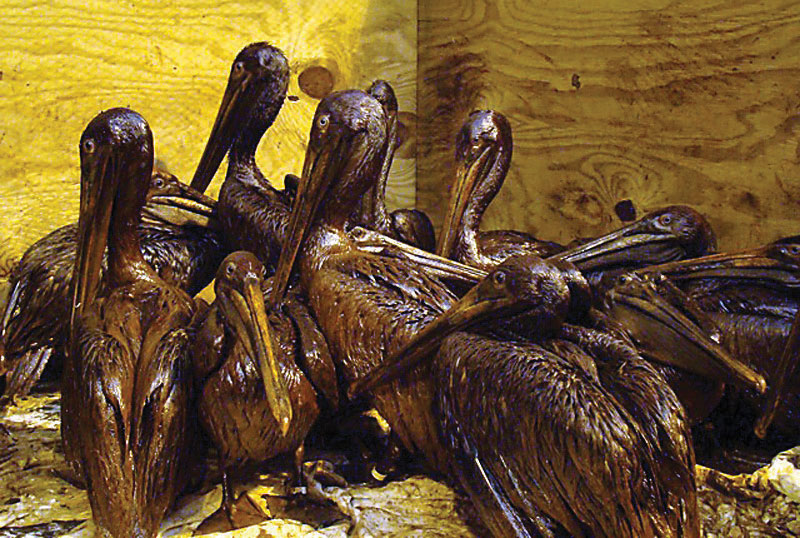
The April 2010 BP oil spill occurred after BP made several decisions that may have increased the possibility of a catastrophic explosion of the well.
International Bird Rescue Research Center – Gulf Oiled Pelicans June 3, 2010 – CC BY 2.0.
A second preventable accident was the 1989 Exxon Valdez oil tanker disaster, in which the tanker hit ground off the coast of Alaska and released 11 million gallons of oil into Prince William Sound. Among other consequences, the spill killed hundreds of thousands of birds and marine animals and almost destroyed the local fishing and seafood industries. The immediate cause of the accident was that the ship’s captain was an alcoholic and left the bridge in the hands of an unlicensed third mate after drinking five double vodkas in the hours before the crash occurred. Exxon officials knew of his alcoholism but let him command the ship anyway. Also, if the ship had had a double hull (one hull inside the other), it might not have cracked on impact or at least would have released less oil, but Exxon and the rest of the oil industry had successfully lobbied Congress not to require stronger hulls.
Hurricane Katrina was a more recent environmental disaster in which human decision making resulted in a great deal of preventable damage. After Katrina hit the Gulf Coast and especially New Orleans in August 2005, the resulting wind and flooding killed more than 1,800 people and left more than 700,000 homeless. McCarthy and King (2009, p. 4) attribute much of this damage to human decision making: “While hurricanes are typically considered ‘natural disasters,’ Katrina’s extreme consequences must be considered the result of social and political failures.” Long before Katrina hit, it was well known that a major flood could easily breach New Orleans levees and have a devastating impact. Despite this knowledge, US, state, and local officials did nothing over the years to strengthen or rebuild the levees. In addition, coastal land that would have protected New Orleans had been lost over time to commercial and residential development. In short, the flooding after Katrina was a human disaster, not a natural disaster.
Environmental Inequality and Environmental Racism
A second emphasis of environmental sociology is environmental inequality and the related concept of environmental racism. Environmental inequality (also called environmental injustice) refers to the fact that low-income people and people of color are disproportionately likely to experience various environmental problems, while environmental racism refers just to the greater likelihood of people of color to experience these problems (Walker, 2012). The term environmental justice refers to scholarship on environmental inequality and racism and to public policy efforts and activism aimed at reducing these forms of inequality and racism. The Note 15.25 “Applying Social Research” box discusses some very significant scholarship on environmental racism.
Applying Social Research
Environmental Racism in the Land of Cotton
During the 1970s, people began to voice concern about the environment in the United States and across the planet. As research on the environment grew by leaps and bounds, some scholars and activists began to focus on environmental inequality in general and on environmental racism in particular. During the 1980s and 1990s, their research and activism spawned the environmental justice movement that has since shed important light on environmental inequality and racism and helped reduce these problems.
Research by sociologists played a key role in the beginning of the environmental justice movement and continues to play a key role today. Robert D. Bullard of Clark Atlanta University stands out among these sociologists for the impact of his early work in the 1980s on environmental racism in the South and for his continuing scholarship since then. He has been called “the father of environmental justice” and was named by Newsweek as one of the thirteen most influential environmental leaders of the twentieth century, along with environmental writer Rachel Carson, former vice president Al Gore, and ten others.
Bullard’s first research project on environmental racism began in the late 1970s after his wife, an attorney, filed a lawsuit on behalf of black residents in Atlanta who were fighting the placement of a landfill in their neighborhood. To collect data for the lawsuit, Bullard studied the placement of landfills in other areas. He found that every city-owned landfill in Houston was in a black neighborhood, even though African Americans amounted to only one-fourth of Houston residents at the time. He also found that three out of four privately owned landfills were in black neighborhoods, as were six of the eight city-owned incinerators. He extended his research to other locations and later recalled what he discovered: “Without a doubt, it was a form of apartheid where whites were making decisions and black people and brown people and people of color, including Native Americans on reservations, had no seat at the table.”
In 1990, Bullard published his findings in his book Dumping in Dixie: Race, Class, and Environmental Quality. This book described the systematic placement in several Southern states of toxic waste sites, landfills, and chemical plants in communities largely populated by low-income residents and/or African Americans. Dumping in Dixie was the first book to examine environmental racism and is widely credited with helping advance the environmental justice movement. It received some notable awards, including the Conservation Achievement Award from the National Wildlife Federation.
More recently, Bullard, along with other sociologists and scholars from other disciplines, has documented the impact of race and poverty on the experience of New Orleans residents affected by the flooding after Hurricane Katrina. As in many other cities, African Americans and other low-income people largely resided in the lower elevations in New Orleans, and whites and higher-income people largely resided in the higher elevations. The flooding naturally had a much greater impact on the lower elevations and thus on African Americans and the poor. After the flood, African Americans seeking new housing in various real estate markets were more likely than whites to be told that no housing was available.
Bullard’s early work alerted the nation to environmental racism and helped motivate the Environmental Protection Agency in the 1990s to begin paying attention to it. His various research efforts are an outstanding example of how social research can increase understanding of a significant social problem.
Sources: Bullard, 1990; Bullard & Wright, 2009; Dicum, 2006
According to the American Sociological Association report mentioned earlier, the emphasis of environmental sociology on environmental inequality reflects the emphasis that the larger discipline of sociology places on social inequality: “A central finding of sociology is that unequal power dynamics shape patterns of social mobility and access to social, political, and economic resources” (Nagel et al., 2010, p. 17). The report adds that global climate change will have its greatest effects on the poorest nations: “Many of the countries least responsible for the rise in greenhouse gases will be most likely to feel its impacts in changes in weather, sea levels, health care costs, and economic hardships” (Nagel et al., 2010, p. 17).
Examples of environmental racism and inequality abound. Almost all the hazardous waste sites we discuss later in this chapter are located in or near neighborhoods and communities that are largely populated by low-income people and people of color. When factories dump dangerous chemicals into rivers and lakes, the people living nearby are very likely to be low-income and of color. Around the world, the people most affected by climate change and other environmental problems are those in poor nations and, even within those nations, those who are poorer rather than those who are wealthier.
Some evidence shows that although low-income people are especially likely to be exposed to environmental problems, this exposure is even more likely if they are people of color than if they are white. As a review of this evidence concluded, “It would be fair to summarize this body of work as showing that the poor and especially the nonwhite poor bear a disproportionate burden of exposure to suboptimal, unhealthy environmental conditions in the United States. Moreover, the more researchers scrutinize environmental exposure and health data for racial and income inequalities, the stronger the evidence becomes that grave and widespread environmental injustices have occurred throughout the United States” (Evans & Kantrowitz, 2002, p. 323).
As should be apparent from the discussion in this section, the existence of environmental inequality and environmental racism shows that social inequality in the larger society exposes some people much more than others to environmental dangers. This insight is one of the most important contributions of environmental sociology.
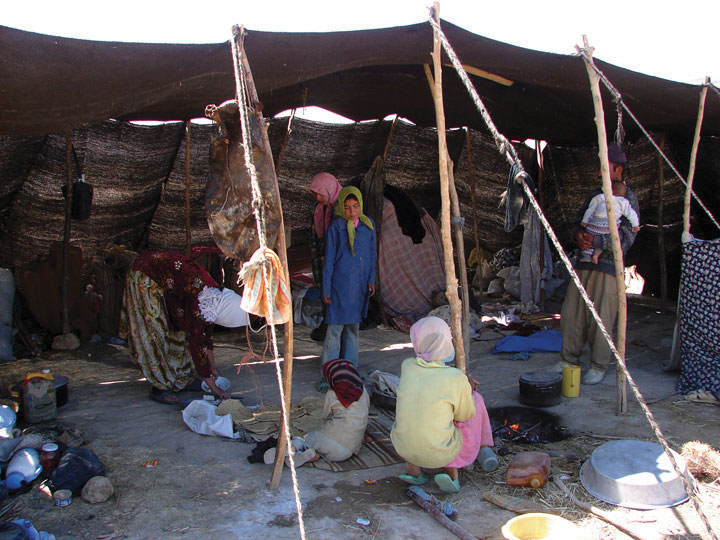
Global climate change is very likely to have its greatest impact on people in the poorest nations, even though these nations are the least responsible for greenhouse gases.
Hamed Saber – The Nomad’s Simple Life – CC BY 2.0.
Environmental Problems
To say that the world is in peril environmentally might sound extreme, but the world is in fact in peril. An overview of environmental problems will indicate the extent and seriousness of this problem.
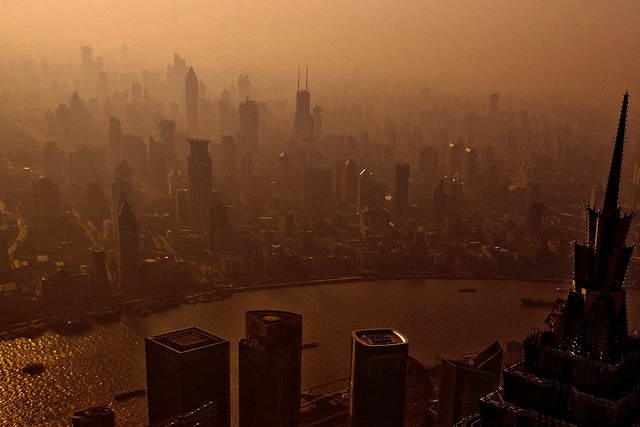
Air pollution probably kills thousands of Americans every year and 2 million people across the planet.
Lei Han – Shanghai – CC BY-NC-ND 2.0.
Air Pollution
Estimates of the annual number of US deaths from air pollution range from a low of 10,000 to a high of 60,000 (Reiman & Leighton, 2010). The worldwide toll is much greater, and the World Health Organization (2011) estimates that 1.3 million people across the globe die every year from air pollution.
These deaths stem from the health conditions that air pollution causes, including heart disease, lung cancer, and respiratory disease such as asthma. Most air pollution stems from the burning of fossil fuels such as oil, gas, and coal. This problem occurs not only in the wealthy industrial nations but also in the nations of the developing world; countries such as China and India have some of the worst air pollution. In developing nations, mortality rates of people in cities with high levels of particulate matter (carbon, nitrates, sulfates, and other particles) are 15–50 percent higher than the mortality rates of those in cleaner cities. In European countries, air pollution is estimated to reduce average life expectancy by 8.6 months. The World Health Organization (2011) does not exaggerate when it declares that air pollution “is a major environmental health problem affecting everyone in developed and developing countries alike.”
Pollution of many types especially harms children’s health. The Note 15.26 “Children and Our Future” box discusses this harm in greater detail.
Children and Our Future
Children and Environmental Health Hazards
As we consider environmental problems, we must not forget the world’s children, who are at special risk for environmental health problems precisely because they are children. Their bodies and brains grow rapidly, and they breathe in more air per pound of body weight than adults do. They also absorb substances, including toxic substances from their gastrointestinal tract faster than adults do.
These and other physiological differences all put children at greater risk than adults for harm from environmental health hazards. Children’s behavior also puts them at greater risk. For example, no adult of normal intelligence would eat paint chips found on the floor, but a young child can easily do so. Children also play on lawns, playgrounds, and other areas in which pesticides are often used, and this type of activity again gives them greater exposure. Young children also put their hands in their mouths regularly, and any toxins on their hands are thereby ingested.
Poverty compounds all these problems. Poor children are more likely to live in houses with lead paint, in neighborhoods with higher levels of air pollution, and in neighborhoods near to hazardous waste sites. Poor children of color are especially at risk for these environmental problems.
Three of the greatest environmental health hazards for children are lead, pesticides, and air pollution. Lead can cause brain and nervous system damage, hearing problems, and delayed growth among other effects; pesticides can cause various problems in the immune, neurological, and respiratory systems; and air pollution can cause asthma and respiratory illnesses. All these health problems can have lifelong consequences.
Unfortunately, certain environmentally induced health problems for children are becoming more common. For example, US children’s asthma cases have increased by more than 40 percent since 1980, and more than four hundred American children now have asthma. Two types of childhood cancer thought to stem at least partly from environmental hazards have also increased during the past two decades: acute lymphocytic by 10 percent and brain tumors by 30 percent.
It should be evident from this overview that environmental health hazards pose a serious danger for children in the United States and the rest of the world. Because children are our future, this danger underscores the need to do everything possible to improve the environment.
Source: Children’s Environmental Health Network, 2009
Global Climate Change
The burning of fossil fuels also contributes to global climate change, often called global warming, thanks to the oft-discussed greenhouse effect caused by the trapping of gases in the atmosphere that is turning the earth warmer, with a rise of almost 1°C during the past century. In addition to affecting the ecology of the earth’s polar regions and ocean levels throughout the planet, climate change threatens to produce a host of other problems, including increased disease transmitted via food and water, malnutrition resulting from decreased agricultural production and drought, a higher incidence of hurricanes and other weather disasters, and extinction of several species (Gillis & Foster, 2012; Zimmer, 2011). All these problems have been producing, and will continue to produce, higher mortality rates across the planet. The World Health Organization (2010) estimates that climate change causes more than 140,000 excess deaths worldwide annually.
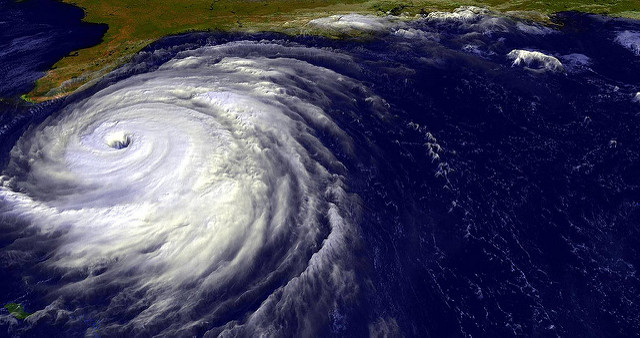
Climate change is causing many problems, including weather disasters such as the one depicted here.
kakela – Hurricane Jeanne – CC BY-NC-ND 2.0.
Another problem caused by climate change may be interpersonal violence and armed conflict (Agnew, 2012; Fisman & Miguel, 2010; Kristof, 2008), already discussed as a consequence of population growth. Historically, when unusual weather events have caused drought, flooding, or other problems, violence and armed conflict have resulted. For example, witch-burnings in medieval Europe accelerated when extremely cold weather ruined crops and witches were blamed for the problem. Economic problems from declining farm values are thought to have increased the lynchings of African Americans in the US South. As crops fail from global warming and reduced rainfall in the years ahead, African populations may plunge into civil war: According to an Oxford University economist, having a drought increases by 50 percent the chance that an African nation will have a civil war a year later (Kristof, 2008).
As we consider climate change, it is important to keep in mind certain inequalities mentioned earlier (McNall, 2011). First, the world’s richest nations contribute more than their fair share to climate change. The United States, Canada, France, Germany, and the United Kingdom compose 15 percent of the world’s population but are responsible for half of the planet’s carbon dioxide emissions. Second, the effects of climate change are more severe for poor nations than for rich nations. Africans, for example, are much less able than Americans to deal with the effects of drought, weather disasters, and the other problems caused by climate change.
Although almost all climate scientists believe that climate change is a serious problem and stems from human behavior, 28 percent of Americans in a November 2011 poll responded “no” when asked, “Is there solid evidence the earth is warming?” Another 18 percent said solid evidence does exist but that global warming is occurring because of “natural patterns” rather than “human activity.” Only 38 percent agreed with climate scientists’ belief that global warming exists and that it arises from human activity (Pew Research Center, 2011).
Overall, 63 percent of respondents agreed that solid evidence of global warming exists (leaving aside the question of why it is occurring). This figure differed sharply by political party preference, however: Whereas 77 percent of Democrats said solid evidence exists, only 43 percent of Republicans and 63 percent of Independents shared this opinion. Similarly, whereas 55 percent of Democrats said global warming is a “very serious” problem, only 14 percent of Republicans and 39 percent of Independents felt this way (Pew Research Center, 2011).
Water Pollution and Inadequate Sanitation
Water quality is also a serious problem. Drinking water is often unsafe because of poor sanitation procedures for human waste in poor nations and because of industrial discharge into lakes, rivers, and streams in wealthy nations. Inadequate sanitation and unsafe drinking water cause parasitic infections and diseases such as diarrhea, malaria, cholera, intestinal worms, typhoid, and hepatitis A. The World Health Organization estimates that unsafe drinking water and inadequate sanitation cause the following number of annual deaths worldwide: (a) 2.5 million deaths from diarrhea, including 1.4 million child deaths from diarrhea; (b) 500,000 deaths from malaria; and (c) 860,000 child deaths from malnutrition. At least 200 million more people annually suffer at least one of these serious diseases due to inadequate sanitation and unsafe drinking water (Cameron, Hunter, Jagals, & Pond, 2011; Prüss-Üstün, Bos, Gore, & Bartram, 2008).
Nuclear Power
Nuclear power has been an environmental controversy at least since the 1970s. Proponents of nuclear power say it is a cleaner energy than fossil fuels such as oil and coal and does not contribute to global warming. Opponents of nuclear power counter that nuclear waste is highly dangerous no matter how it is disposed, and they fear meltdowns that can result if nuclear power plant cores overheat and release large amounts of radioactive gases into the atmosphere.
The most serious nuclear plant disaster involved the Chernobyl plant in Ukraine in 1986. Chernobyl’s core exploded and released radioactive gases into the atmosphere that eventually spread throughout Europe. The amount of radiation released was four hundred times greater than the amount released by the atomic bomb that devastated Hiroshima at the end of World War II. About five-dozen people (Chernobyl workers or nearby residents) soon died because of the disaster. Because radiation can cause cancer and other health problems that take years to develop, scientists have studied the health effects of the Chernobyl disaster for the last quarter-century. According to the United Nations Scientific Committee of the Effects of Atomic Radiation (UNSCEAR), an estimated 27,000 additional cancer deaths worldwide will eventually result from the Chernobyl disaster (Gronlund, 2011).
Seven years earlier in March 1979, a nuclear disaster almost occurred in the United States at the Three Mile Island plant in central Pennsylvania. A series of technological and human failures allowed the plant’s core to overheat to almost disastrous levels. The nation held its breath for several days while officials sought to bring the problem under control. During this time, some 140,000 people living within twenty miles of the plant were evacuated. The near disaster severely weakened enthusiasm for nuclear power in the United States, and the number of new nuclear plants dropped sharply in the ensuing two decades (Fischer, 1997).
Japan was the site of the worst nuclear disaster since Chernobyl in March 2011, when an earthquake and tsunami seriously damaged a nuclear plant in the Fukushima region, 155 miles north of Tokyo. More than 80,000 residents had to be evacuated because of the massive release of radioactive gases and water, and they remained far from their homes a year later as high levels of radiation continued to be found in the evacuated area. A news report on the anniversary of the disaster described the desolation that remained: “What’s most striking about Japan’s nuclear exclusion zone is what you don’t see. There are no people, few cars, no sign of life, aside from the occasional livestock wandering empty roads. Areas once home to 80,000 people are now ghost towns, frozen in time. Homes ravaged from the powerful earthquake that shook this region nearly a year ago remain virtually untouched. Collapsed roofs still block narrow streets. Cracked roads make for a bumpy ride” (Fujita, 2012). It will take at least thirty years to fully decommission the damaged reactors at Fukushima. The news report said, “This nuclear wasteland may not be livable for decades” (Fujita, 2012).
In February 2012, the US Nuclear Regulatory Commission (NRC) issued a study that said the risk from nuclear power accidents in the United States was “very small.” If an accident should occur, the NRC concluded, plant operators would have time to cool down reactor cores and prevent or reduce the emission of radiation (DiSavino, 2012). However, the Union of Concerned Scientists (UCS) is more concerned about this risk (Union of Concerned Scientists, 2011). It says that several US reactors are of the same design as the Fukushima reactors and thus potentially at risk for a similar outcome if damaged by an earthquake. According to the UCS, “If [these reactors] were confronted with a similar challenge, it would be foolish to assume the outcome would not also be similar.” It adds that although earthquakes can cause fires at reactors, US plants routinely violate fire protection standards. A news report on the similarities between US nuclear power plants and the Fukushima plant reached a similar conclusion, noting that US nuclear power plants “share some or all of the risk factors that played a role at Fukushima” (Zeller, 2011).
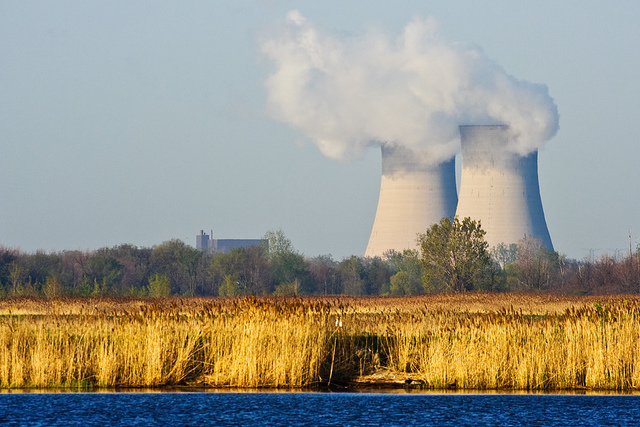
Critics say many US nuclear plants lack adequate protection against several kinds of dangers.
James Marvin Phelps – Nuclear Wetlands – CC BY-NC 2.0.
As this conclusion implies, nuclear power critics say NRC oversight of the nuclear industry is too lax. A 2011 investigation by the Associated Press (AP) yielded support for this criticism (Donn, 2011). The AP found that the NRC has been “working closely with the nuclear power industry to keep the nation’s aging reactors operating within safety standards by repeatedly weakening those standards or simply failing to enforce them.” The report continued, “Time after time, officials at the [NRC] have decided that original regulations were too strict, arguing that safety margins could be eased without peril.” For example, when certain valves at nuclear plants leaked, the NRC revised its regulations to permit more leakage. Also, when cracking of steam generator tubes allowed radiation to leak, standards on tubing strength were weakened. And when reactors began to violate temperature standards, the NRC almost doubled the permitted temperatures. The investigation found “thousands” of problems in aging reactors that it said the NRC have simply ignored, and it concluded that a “cozy relationship” exists between the NRC and the nuclear industry.
A retired NRC engineer interviewed by the AP agreed that his former employer too often accommodated the nuclear industry by concluding that existing regulations are overly stringent. “That’s what they say for everything, whether that’s the case or not,” the engineer said. “They say ‘We have all this built-in conservatism.’”
Ground Pollution and Hazardous Waste
Pollution of the air and water is an environmental danger, as we saw earlier, but so is pollution of the ground from hazardous waste. Hazardous wastes are unwanted materials or byproducts that are potentially toxic. If discarded improperly, they enter the ground and/or bodies of water and eventually make their way into the bodies of humans and other animals and/or harm natural vegetation.
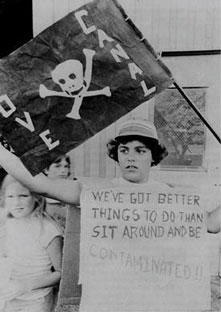
Love Canal, an area in Niagara Falls, New York, was the site of chemical dumping that led to many birth defects and other health problems.
Wikimedia Commons – public domain.
Two major sources of hazardous waste exist: (1) commercial products such as pesticides, cleaning fluids, and certain paints, batteries, and electronics and (2) byproducts of industrial operations such as solvents and wastewater. Hazardous waste enters the environment through the careless actions of homeowners and other consumers, and also through the careless actions of major manufacturing corporations. It can cause birth defects, various chronic illnesses and conditions, and eventual death.
Sometimes companies have dumped so much hazardous waste into a specific location that they create hazardous waste sites. These sites are defined as parcels of land and water that have been contaminated by the dumping of dangerous chemicals into the ground by factories and other industrial operations. The most famous (or rather, infamous) hazardous waste site in the United States is undoubtedly Love Canal, an area in a corner of Niagara Falls, New York. During the 1940s and 1950s, a chemical company dumped 20,000 tons of toxic chemicals into the canal and then filled it in with dirt and sold it for development to the local school board. A school and more than eight hundred homes, many of them low income, were later built just near the site. The chemicals eventually leached into the groundwater, yards, and basements of the homes, reportedly causing birth defects and other health problems. (See Note 15.27 “People Making a Difference”.)
People Making a Difference
In Praise of Two Heroic Women
In the annals of activism against hazardous waste dumping, two women stand out for their contributions.
One was Lois Gibbs, who led a movement of residents of Love Canal to call attention to the dumping of hazardous waste in their neighborhood, as just discussed in the text. Gibbs had never been politically active before 1978, when evidence of the dumping first came to light. After reading a newspaper article about the dumping, she began a petition to shut down a local school that was next to the dump site. Her efforts generated a good deal of publicity and prompted state officials to perform environmental tests in the homes near the site. Two years later the federal government authorized funding to relocate 660 families from the dangerous area. Gibbs later wrote, “It will take a massive effort to move society from corporate domination, in which industry’s rights to pollute and damage health and the environment supersede the public’s right to live, work, and play in safety. This is a political fight. The science is already there, showing that people’s health is at risk. To win, we will need to keep building the movement, networking with one another, planning, strategizing, and moving forward. Our children’s futures, and those of their unborn children, are at stake.”
The second woman was Erin Brockovich, the subject of a 2000 film of that name starring Julia Roberts. Brockovich also was not politically active before she discovered hazardous waste dumping while she was working as a legal assistant for a small California law firm. As part of her work on a real estate case, she uncovered evidence that Pacific Gas & Electric had been dumping a toxic industrial solvent for thirty years into the water supply of the small town of Hinkley. Her investigation led to a lawsuit that ended in 1996 with the awarding of $333 million in damages to several hundred Hinkley residents.
Both Lois Gibbs and Erin Brockovich have remained active on behalf of environmental safety in the years since their celebrated initial efforts. They are two heroic women who have made a very significant difference.
Sources: Brockovich, 2010; Gibbs, 1998
The Superfund program of the US Environmental Protection Agency (EPA), begun about thirty years ago, monitors and cleans up hazardous waste sites throughout the country. Since its inception, the Superfund program has identified and taken steps to address more than 1,300 hazardous waste sites. About 11 million people live within one mile of one of these sites.
Oceans
The world’s oceans are at peril for several reasons, with “potentially dire impacts for hundreds of millions of people across the planet,” according to a news report (ScienceDaily, 2010). A major reason is that overfishing of fish and mammals has dramatically reduced the supply of certain ocean animals. This reduction certainly makes it difficult for people to eat certain fishes at restaurants or buy them at supermarkets, but a far more important problem concerns the ocean food chain (Weise, 2011). As the supply of various ocean animals has dwindled, the food supply for the larger ocean animals that eat these smaller animals has declined, putting the larger animals at risk. And as the number of these larger animals has declined, other animals that prey on these larger animals have had to turn to other food sources or not have enough to eat. This chain reaction in the ocean food chain has serious consequences for the ocean’s ecosystem.
One example of this chain reaction involves killer whales and sea otters in the ocean off of western Alaska (Weise, 2011). Killer whales eat many things, but sea lions and harbor seals form a key part of their diet. However, the supply of these ocean mammals in western Alaska and elsewhere has decreased because of human overfishing of their prey fish species. In response, killer whales have been eating more sea otters, causing a 90 percent decline in the number of sea otters in western Alaska. Because sea otters eat sea urchins, the loss of sea otters in turn has increased the number of sea urchins there. And because sea urchins consume kelp beds, kelp beds there are disappearing, removing a significant source of food for other ocean life (Estes et al., 2011).
Another example of the ocean chain reaction concerns whales themselves. The whaling industry that began about 1,000 years ago and then intensified during the eighteenth century severely reduced the number of whales and made right whales almost extinct. In southern oceans, whale feces are an important source of nutrients for very small animals and plankton. As the whale population in these oceans has declined over the centuries, these animals and plankton that are essential for the ocean’s ecosystem have suffered immeasurable losses (Weise, 2011).
Bycatch. In addition to overfishing, bycatch, or the unintentional catching and killing of fish, marine mammals, sea turtles, and seabirds while other fish are being caught, also endangers hundreds of ocean species and further contributes to the chain reaction we have described. The US National Oceanic and Atmospheric Administration (2012) says that bycatch “can have significant social, environmental, and economic impacts.” It costs the fishing industry much time and money, it threatens many ocean species, and it endangers the ocean’s ecosystem.
A familiar bycatch example to many Americans is the accidental catching and killing of dolphins when tuna are being caught by large fishing nets. A less familiar example involves sea turtles. These animals’ numbers have declined so steeply in recent decades that six of the seven species of sea turtles are in danger of extinction. The major reason for this danger is bycatch from shrimp trawl nets and other types of fishing. This bycatch has killed millions of sea turtles since 1990 (Viegas, 2010).
Climate change. Other ocean problems stem from climate change. The oceans’ coral reefs are among the most colorful and beautiful sights in the world. More important, they are an essential source of nutrients for the oceans’ ecosystem and a major source of protein for 500 million people. They help protect shorelines from natural disasters such as tsunamis, and they attract tens of billions of dollars in tourism.

The decline of the whale population due to the whaling industry threatens the world’s supply of plankton and other very small marine animals.
Denis Hawkins – Whale breaching at Jervis Bay – CC BY-ND 2.0.
Despite all these benefits, coral reefs have long been endangered by overfishing, tourism, and coastal development, among other factors. Scientists have now found that climate change is also harming coral reefs (Rudolf, 2011). The global warming arising from climate change is overheating coral reefs throughout the world. This overheating in turn causes the reefs to expel the algae they consume for food; the algae are also responsible for the reefs’ bright colors. The reefs then turn pale and die, and their deaths add to the ocean’s food chain problem already discussed. Scientists estimate that three-fourths of the earth’s reefs are at risk from global warming, and that one-fifth of all reefs have already been destroyed. They further estimate that almost all reefs will be at risk by 2050.
Global warming will continue to be a main culprit in this regard, but so will increasing acidity, yet another problem arising from climate change. As carbon dioxide is released into the atmosphere, much of it falls into the ocean. This lowers the oceans’ pH level and turns the oceans more acidic. This increasing acidity destroys coral reefs and also poses a risk to commercial species such as clams, lobsters, and mussels.
An additional ocean problem stemming from climate change is rising sea levels (Daley, 2011). Global warming has caused polar ice caps to melt and the seas to rise. This problem means that storm surges during severe weather are becoming an ever-greater problem. Even without storm surges, much coastal land has already been lost to rising ocean levels. Despite these problems, many coastal communities have failed to build adequate barriers that would minimize damage from ocean flooding.
Food
This chapter discussed food shortages earlier as a population problem, but food can also be an environmental hazard. Simply put, food is often unsafe to eat. In 2011, at least 31 Europeans died from a rare strain of E. coli, a deadly bacterium, and more than 3,000 became very ill; the culprit was contaminated bean sprouts (CNN, 2011). According to the Centers for Disease Control and Prevention, 325,000 Americans are hospitalized annually because of illnesses contracted from contaminated food, and 5,000 Americans die each year from these illnesses (Kristof, 2011).
The deadly bacteria at fault often result from improper handling and other activities related to growing livestock and processing food. But they also result from the fact that livestock are routinely given antibiotics to keep them healthy despite the crowded and often dirty conditions in which they live. However, this wide use of antibiotics allows bacteria resistant to antibiotics to grow. When humans contract illnesses from these bacteria, antibiotics do not relieve the illnesses (Kristof, 2012).
One journalist pointed out the obvious problem: “We would never think of trying to keep our children healthy by adding antibiotics to school water fountains, because we know this would breed antibiotic-resistant bacteria. It’s unconscionable that Big Ag [Big Agriculture] does something similar for livestock” (Kristof, 2011, p. WK10). A member of the US House of Representatives who is also a microbiologist agreed: “These statistics tell the tale of an industry that is rampantly misusing antibiotics in an attempt to cover up filthy, unsanitary living conditions among animals. As they feed antibiotics to animals to keep them healthy, they are making our families sicker by spreading these deadly strains of bacteria” (Kristof, 2011, p. WK10).
Key Takeaways
- Environmental problems are largely the result of human behavior and human decision making. Changes in human activity and decision making are thus necessary to improve the environment.
- Environmental inequality and environmental racism are significant issues. Within the United States and around the world, environmental problems are more often found where poor people and people of color reside.
- Air pollution, global climate change, water pollution and inadequate sanitation, and hazardous waste are major environmental problems that threaten the planet.
For Your Review
- Pretend you are on a debate team and that your team is asked to argue in favor of the following resolution: Be it resolved, that air and water pollution is primarily the result of reckless human behavior rather than natural environmental changes. Using evidence from the text, write a two-minute speech (about three hundred words) in favor of the resolution.
- How much of the environmental racism that exists do you think is intentional? Explain your answer.
- List one thing you did yesterday that was good for the environment and one thing that was bad for the environment.
References
Agnew, R. (2012). Dire forecast: A theoretical model of the impact of climate change on crime. Theoretical Criminology, 16, 21–42.
Brockovich, E. (2010). Erin Brockovich biography. Retrieved February 8, 2012, from http://www.brockovich.com/mystory.html.
Bullard, R. D. (1990). Dumping in Dixie: Race, class, and environmental quality. Boulder, CO: Westview Press.
Bullard, R. D., & Wright, B. (2009). Race, place, and the environment in post-Katrina New Orleans. In R. D. Bullard & B. Wright (Eds.), Race, place, and environmental justice after hurricane Katrina: Struggles to reclaim, rebuild, and revitalize New Orleans and the Gulf Coast (pp. 19–48). Boulder, CO: Westview Press.
Cameron, J., Hunter, P., Jagals, P., & Pond, K. (Eds.). (2011). Valuing water, valuing livelihoods. London, United Kingdom: World Health Organization.
Children’s Environmental Health Network. (2009). An introduction to children’s environmental health. Retrieved February 8, 2012, from http://www.cehn.org/introduction_childrens_environmental_health.
CNN. (2011, June 10). E. coli death toll rises to 31; sprouts traced to trash in home. CNN World. Retrieved from http://articles.cnn.com/2011-06-10/world/europe.e.coli_1_coli-outbreak-sprouts-german-health?_s=PM:WORLD.
Daley, B. (2011, April 3). Fighting a losing battle with the sea. Boston.com. Retrieved from http://www.boston.com/news/science/articles/2011/04/03/fighting_a_losing_battle_with_the_sea.
Dicum, G. (2006, March 14). Meet Robert Bullard, the father of environmental justice. Grist Magazine. Retrieved from http://www.grist.org/article/dicum.
DiSavino, S. (2012, February 1). Nuclear accidents pose little risk to health: NRC. Reuters. Retrieved from http://www.reuters.com/article/2012/02/01/us-utilities-nuclear-accidentstudy-idUSTRE8101ZA20120201.
Donn, J. (2011, June 20). As nuclear plants age, NRC loosens safety regulations. The Boston Globe, p. A2.
Estes, J. A., Terborgh, J., Brashares, J. S., Power, M. E., Berger, J., Bond, W. J., et al. (2011). Trophic downgrading of planet Earth. Science, 333(6040), 301–306.
Evans, G. W., & Kantrowitz, E. (2002). Socioeconomic status and health: The potential role of environmental risk exposure. Annual Review of Public Health, 23(1), 303.
Fischer, D. (1997). History of the International Atomic Energy Agency: The first forty years. Vienna, Austria: Internatinal Atomic Energy Agency.
Fisman, R., & Miguel, E. (2010). Economic gangsters: Corruption, violence, and the poverty of nations. Princeton, NJ: Princeton University Press.
Fountain, H. (2010, June 15). Documents show risky decisions before BP blowout. New York Times, p. A1.
Fujita, A. (2012, February 6). Japan’s nuclear exclusion zone shows few signs of life. ABC News. Retrieved from http://abcnews.go.com/International/fukushimas-nuclear-exclusion-zone-shows-signs-life/story?id=15521091#.TzFSXONSRyc.
Gibbs, L. M. (1998). Learning from Love Canal: A 20th anniversary retrospective. Retrieved February 8, 2012, from http://arts.envirolink.org/arts_and_activism/LoisGibbs.html.
Gillis, J., & Foster, J. M. (2012, March 29). Weather runs hot and cold, so scientists look to the ice. New York Times, p. A1.
Gronlund, L. (2011). How many cancers did Chernobyl really cause?—updated version. Cambridge, MA: Union of Concerned Scientists.
King, L., & McCarthy, D. (Eds.). (2009). Environmental sociology: From analysis to action (2nd ed.). Lanham, MD: Rowman & Littlefield.
Kristof, N. (2012, April 5). Arsenic in our chicken? New York Times, p. A23.
Kristof, N. D. (2008, April 13). Extended forecast: Bloodshed. New York Times. Retrieved from http://www.nytimes.com/2008/04/13/opinion/13kristof.html.
Kristof, N. D. (2011, June 12). When food kills. New York Times, p. WK10.
McCarthy, D., & King, L. (2009). Introduction: Environmental problems require social solutions. In L. King & D. McCarthy (Eds.), Environmental Sociology: From Analysis to Action (2nd ed., pp. 1–22). Lanham, MD: Rowman & Littlefield.
McNall, S. G. (2011). Rapid climate change: Causes, consequences, and solutions. New York, NY: Routledge.
Nagel, J., Dietz, T., & Broadbent, J. (Eds.). (2010). Workshop on sociological perspectives on global climate change. Washington, DC: National Science Foundation.
National Oceanic and Atmospheric Administration. (2012). National bycatch program. Retrieved February 13, 2012, from http://www.nmfs.noaa.gov/by_catch/index.htm.
Pew Research Center. (2011). Modest rise in number saying there is “solid evidence” of global warming. Washington, DC: Author.
Prüss-Üstün, A., Bos, R., Gore, F., & Bartram, J. (2008). Safer water, better health: Costs, benefits, and sustainability of interventions to protect and promote health. Geneva, Switzerland: World Health Organization.
Reiman, J., & Leighton, P. (2010). The rich get richer and the poor get prison: Ideology, class, and criminal justice (9th ed.). Upper Saddle River, NJ: Prentice Hall.
Rudolf, J. C. (2011, June 5). Under the sea, coral reefs in peril. New York Times, p. WK3.
ScienceDaily. (2010, June 19). Ocean changes may have dire impact on people. ScienceDaily. Retrieved from http://www.sciencedaily.com/releases/2010/06/100618103558.htm.
Union of Concerned Scientists. (2011). Nuclear reactor crisis in Japan FAQs. Retrieved from http://www.ucsusa.org/nuclear_power/nuclear_power_risk/safety/nuclear-reactor-crisis-faq.html#us-plant-risk.
Viegas, J. (2010, April 6). Millions of sea turtles captured, killed by fisheries. Discovery News. Retrieved from http://news.discovery.com/animals/turtles-bycatch-fishing.html.
Walker, G. (2012). Environmental justice: Concepts, evidence, and politics. New York, NY: Routledge.
Weise, E. (2011, July 15). Predator loss can start food-chain reaction. USA Today, p. 9A.
World Health Organization. (2011). Air quality and health. Retrieved from http://www.who.int/mediacentre/factsheets/fs313/en/index.html.
World Health Organization. (2010). Climate change and health. Retrieved from http://www.who.int/mediacentre/factsheets/fs266/en/index.html.
Zeller, T., Jr. (2011, March 14). US nuclear plants have same risks, and backups, as Japan counterparts. New York Times, p. A10.
Zimmer, C. (2011, April 5). Multitude of species face climate threat. New York Times, p. D1.

